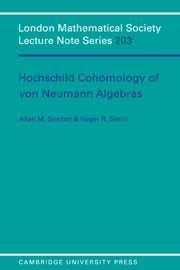5 - Hyperfinite Subalgebras
Published online by Cambridge University Press: 29 September 2009
Summary
Introduction
This chapter contains three different techniques, each associated with hyperfinite von Neumann algebras, which play an important role in the next chapter on continuous cohomology. The technique in the first section is due to Kadison and Ringrose [KR3] and is based on a generalization of the old idea of Murray and von Neumann that if x ∈ M and y ∈ M′ with xy = 0 then there is a z ∈ M ∩ M′, the centre of both M and M′, such that xz = 0 and zy = y. For module maps over the centre this enables us to extend multilinear maps algebraically by a subalgebra of the commutant, provided this subalgebra is abelian. The extension can be shown to be norm continuous and behaves well with respect to the coboundary operator. This theory is developed in Section 5.2 and leads to the continuous cocycles from Mn into M being coboundaries into larger algebras.
Section 5.3 is devoted to three remarkable results of Popa on the existence of hyperfinite subfactors in type II1 factors with trivial relative commutants, and a result of his on maximal abelian self-adjoint subalgebras (masas). The first is that there is a hyperfinite subfactor N of a type II1 factor M with trivial relative commutant (that is, N′ ∩ M = C1) (5.3.6). In the second N is constructed to contain a preassigned Cartan subalgebra A(5.3.9). In the third a masa in B(L2(M)) is constructed from a Cartan subalgebra (5.3.11).
- Type
- Chapter
- Information
- Hochschild Cohomology of Von Neumann Algebras , pp. 114 - 145Publisher: Cambridge University PressPrint publication year: 1995



